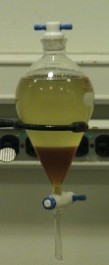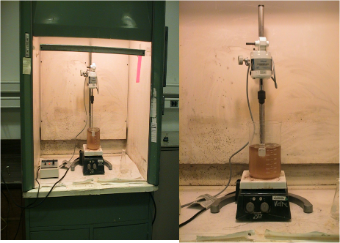Grow Your Own Algae: The Process
Step 1: We began by growing microalgae indoors in recycled plastic water bottles. We monitored the pH and temperature of the microalgae to make sure growing conditions were optimal daily. We also made sure the microalgae were had nutrients, carbon dioxide and fluorescent light to optimize growing conditions. As the microalgae continued to replicate, we continued to expand our cultures until we had sufficent quantities of microalgae to extract a sizable amount of oil. |  |
Step 2: As the photoboireactors (PBR) "greened", we harvested the microalgae by gravity filtration and recycled the water into another PBR. |  |
Step 3: Then, we used a 12 ton hydraulic shop-press to extract the microalgae oil from the completely air-dried microalgae.Oil dropped into the bucket below. |
|
Step 4 Under the direction and assistance of Dr. Thomas Butcher and Chris Brown, our microalgae oil was converted into biodiesel by transesterifaction with methanol and sodium hydroxide at Brookhaven National Lab. Due to gravity separation, the biodiesl separated from the residual glycerin, excess methanol and soap. Gycerin and other waste products settled to the bottom while the biodiesel rose to the top. We washed the biodiesel to get rid of any remaining waste products. |
|
Step 5 Finally under the direction of Dr. Tom Butcher at Brookhaven National Lab, we tested combustion effiencies and emissions our microalgae biodiesel as compared to soybean biodiesel and petroleum based #2 heating oil in a residental boiler. We measure the levels of carbon monoxide, sulfur dioxide, and nitric oxide. When comparing microalgae biodiesel to #2 oil and soybean biodiesel, we found that microalgae biodiesel burns more cleaner and has lower toxic emmisions compared to #2 heating oil. (Soybean biodiesel had similar results to microalgae biodiesel.) |  |
Video Displaying the Combustion of Microalgae Biodiesel in a Home Boiler
Interview with Dr. Tom Butcher & Chris Brown, Brookhaven National Lab.


